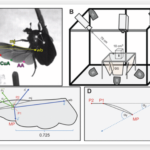Paper, Elastic wing deformations mitigate flapping asymmetry during manoeuvres in rose chafers (Protaetia cuprea)
To manoeuvre in air, flying animals produce asymmetric flapping between contralateral wings. Unlike the adjustable vertebrate wings, insect wings lack intrinsic musculature, preventing active control over wing shape during flight. However, the wings elastically deform as a result of aerodynamic and inertial forces generated by the flapping motions. How these elastic deformations vary with flapping kinematics and flight performance in free-flying insects is poorly understood. Using high-speed videography, we measured how contralateral wings elastically deform during free-flight manoeuvring in rose chafer beetles (Protaetia cuprea). We found that asymmetric flapping during aerial turns was associated with contralateral differences in chord-wise wing deformations. The highest instantaneous difference in deformation occurred during stroke reversals, resulting from differences in wing rotation timing. Elastic deformation asymmetry was also evident during mid-strokes, where wing compliance increased the angle of attack of both wings, but reduced the asymmetry in the angle of attack between contralateral wings. A biomechanical model revealed that wing compliance can increase the torques generated by each wing, providing higher potential for manoeuvrability, while concomitantly contributing to flight stability by attenuating steering asymmetry. Such stability may be adaptive for insects such as flower chafers that need to perform delicate low-speed landing manoeuvres among vegetation
Learn about our two Decals!
 Click here to find out more about our Fall Bioinspired Design Decal and our Spring Bioinspired Design in Action Decal – ALL MAJORS are welcome.
Click here to find out more about our Fall Bioinspired Design Decal and our Spring Bioinspired Design in Action Decal – ALL MAJORS are welcome.Berkeley BioDesign Community
 Click here to learn about the BioD: Bio-Inspired Design @ Berkeley student organization or here to signup for more info.
Click here to learn about the BioD: Bio-Inspired Design @ Berkeley student organization or here to signup for more info.Search
Student Login





I imagine that the neurological circuits underlying these processes are governed by both 2d spacing maps with their brains as…
to reduce the impact of car accidents, it may be possible to study the force diverting physics of cockroaches to…
you see this type of head-bobbing stability in many avian creatures related to pigeons like chickens. the head ability to…
not like they taught horses how to run! this is an example of convergent evolution where both sea creatures and…
The brain functions in a similar way with neuronal connections. our brains are able to utilize the multiplicity of connections…